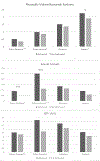Online Sexual Experiences Predict Subsequent Sexual Health and Victimization Outcomes Among Female Adolescents: A Latent Class Analysis
- PMID: 30778831
- PMCID: PMC7135936
- DOI: 10.1007/s10964-019-00995-3
Online Sexual Experiences Predict Subsequent Sexual Health and Victimization Outcomes Among Female Adolescents: A Latent Class Analysis
Abstract
Adolescents' online sexual experiences (e.g., pornography use, sexual chatting, sexualized social media use, and nude image exchange) provide a new context for sexual socialization. Traditionally, online sexual experiences are often aggregated averages, which neglect their complexity and fail to identify individual differences in the experience. Moreover, the lack of longitudinal research in this area has failed to determine if these experiences predict later offline sexual health and violence outcomes. An analysis of two waves of surveys completed by ethnically and socioeconomically diverse female adolescents (N = 296; 49% maltreated; aged 14-16 years) participating in a larger cross-sequential study was conducted to address these gaps. Established latent classes from the prerequisite study of online sexual experiences at Time 1 were Online Abstinent (low probability of any online sexual experiences), Online Inclusive (high probability of all online sexual experiences), Attractors (high probability of attracting attention from others), and Seekers (high probability of seeking out sexual content and interaction). Class membership uniquely predicted HIV risk, number of physically violent romantic partners, and the occurrence of sexual assault at Time 2. Although membership in risker online sexual experience classes predicted later offline risk and victimization, this was especially true for maltreated participants. These findings demonstrate the advantages of examining online sexual experiences in a way that emphasizes their complexity and individual differences in influential susceptibility.
Keywords: Maltreatment; Media; Pornography; Sexting; Sexual violence; Social media.
Figures

Similar articles
-
A Latent Class Analysis of Online Sexual Experiences and Offline Sexual Behaviors Among Female Adolescents.J Res Adolesc. 2018 Sep;28(3):731-747. doi: 10.1111/jora.12364. Epub 2017 Nov 20. J Res Adolesc. 2018. PMID: 29152811 Free PMC article.
-
Pornography, Sexual Coercion and Abuse and Sexting in Young People's Intimate Relationships: A European Study.J Interpers Violence. 2018 Oct;33(19):2919-2944. doi: 10.1177/0886260516633204. Epub 2016 Mar 6. J Interpers Violence. 2018. PMID: 26951609
-
Predictors of unwanted exposure to online pornography and online sexual solicitation of youth.J Health Psychol. 2016 Jun;21(6):1107-18. doi: 10.1177/1359105314546775. Epub 2014 Aug 31. J Health Psychol. 2016. PMID: 25179645
-
Cyber safety for adolescent girls: bullying, harassment, sexting, pornography, and solicitation.Curr Opin Obstet Gynecol. 2014 Oct;26(5):360-5. doi: 10.1097/GCO.0000000000000106. Curr Opin Obstet Gynecol. 2014. PMID: 25136759 Review.
-
Sex Online: Pornography, Sexual Solicitation, and Sexting.Adolesc Med State Art Rev. 2014 Dec;25(3):574-89. Adolesc Med State Art Rev. 2014. PMID: 27120886 Review. No abstract available.
Cited by
-
Understanding posttraumatic stress trajectories in adolescent females: A strength-based machine learning approach examining risk and protective factors including online behaviors.Dev Psychopathol. 2023 Oct;35(4):1794-1807. doi: 10.1017/S0954579422000475. Epub 2022 May 30. Dev Psychopathol. 2023. PMID: 35635211 Free PMC article.
-
Sexual Experiences and Beliefs Vary by Patterns of Pornography Genre Preferences Among Women.J Sex Marital Ther. 2023;49(6):659-672. doi: 10.1080/0092623X.2023.2174225. Epub 2023 Feb 6. J Sex Marital Ther. 2023. PMID: 36744624 Free PMC article.
-
"We're all still learning about how to talk about porn": Teacher and administrator perspectives about inclusion of education about pornography in Massachusetts high school sex education programs.Sex Res Social Policy. 2025 Mar;22(1):413-422. doi: 10.1007/s13178-024-00944-1. Epub 2024 Mar 5. Sex Res Social Policy. 2025. PMID: 40666497 Free PMC article.
-
Latent Heterogeneity of Online Sexual Experiences and Associations With Sexual Risk Behaviors and Behavioral Health Outcomes in Chinese Young Adults: Cross-Sectional Study.JMIR Public Health Surveill. 2024 Jan 26;10:e50020. doi: 10.2196/50020. JMIR Public Health Surveill. 2024. PMID: 38277190 Free PMC article.
-
Online risk exposure and anxiety among college students in China: The chain mediating role of negative attribution and interpersonal security.PLoS One. 2025 Mar 19;20(3):e0319700. doi: 10.1371/journal.pone.0319700. eCollection 2025. PLoS One. 2025. PMID: 40106410 Free PMC article.
References
-
- Bakk Z, & Vermunt JK (2016). Robustness of stepwise latent class modeling with continuous distal outcomes. Structural Equation Modeling: A Multidisciplinary Journal, 23, 20–31.
-
- Bay-Cheng LY (2015). The agency line: A neoliberal metric for appraising young women’s sexuality. Sex Roles, 73, 279–291.
-
- Bensley LS, Eenwyk J. Van, & Simmons KW (2000). Self-reported childhood sexual and physical abuse and adult HIV-risk behaviors and heavy drinking. American Journal of Preventive Medicine, 18, 151–158. - PubMed
-
- Bergman LR, & Trost K (2006). The person-oriented versus the variable-oriented approach: Are they complementary, opposites, or exploring different worlds? Merrill-Palmer Quarterly, 52, 601–632.
MeSH terms
Grants and funding
LinkOut - more resources
Full Text Sources
Medical

